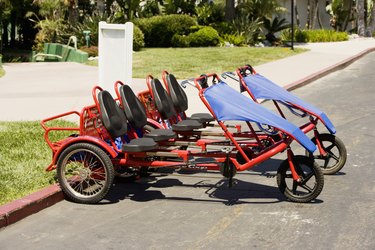
If you want to ride a bike, you'll have to choose between two options: the upright bike and the recumbent bike. Stationary upright bikes are similar to regular street bikes on which you sit straight up; they're the type of bikes used for indoor cycling classes. Recumbent bikes allow riders to sit in a reclining position. Whether you're choosing an upright or a recumbent bike, you need to make sure you're positioning your body properly in order to avoid injury and make the most of your workout.
Reasons to Choose a Recumbent Bike
Video of the Day
One of the most common reasons for using a recumbent bike is comfort. Not only do they have a large seat, but the bikes also offer complete back support. This ergonomic advantage is especially important for people with back or neck problems. Because of their low center of gravity, recumbent bikes are also more aerodynamic and can pick up speed more easily.
Video of the Day
Seat Positioning
In a recumbent bike, you adjust the seat either forward or backwards, rather than up or down like an upright bike. Relax against the back of your seat, in the position in which you're most likely to ride and then reach towards the pedal. If the seat recline allows for adjustments, start at a mid-position. According to Bacchetta Bikes, being too straight or too reclined can cause discomfort and pain for beginner riders. An uncomfortable seat position can also put additional stress on your knees and make riding more difficult.
Leg Positioning
Extend your legs and place your feet on the pedals. When riding a recumbent bike, your leg should have only a very small bend. Start with legs completely straight and then adjust the seat enough so that your knees never lock when pedaling. In a recumbent bike, this means an angle of just a few degrees. Make sure your legs don't bend too much at any given time, since this puts a lot of pressure on your knees.
Knee Strain
Because your legs are always extended forward, you might end up with sore knees after riding a recumbent bike. This is especially true if you're a beginner rider or if your muscles are not strong enough to sustain the weight of your legs. Because recumbent bikes put all the stress on your legs, your back and neck are not as strained. The more you lean back on your seat, the more you have to use your legs and the less pressure you put on your back and other parts of your body. Recumbent bikes also require little wrist and lower arm strength, while upright bikes put a lot of pressure on your arms and shoulders because you have to lean on the handlebars.